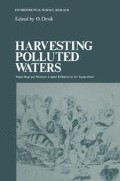Abstract
Higher aquatic plants have mostly been underestimated with regard to their primary production potential and their importance as the basis of aquatic food chains. This neglect of macrophytes is especially obvious in limnology (Thienemann, 1926), where the research is concentrated almost exclusively on the pelagic vegetation, the phytoplankton. But in marine biology, as well, the investigation of higher plants (angiosperms) has received far less attention than the planktonic algae or the seaweeds. It is only in recent years that a change has come about (Gaevskaya, 1966). From World War II onward a steadily increasing number of publications pointed out that the role of higher plants in primary production in the shallow areas of fresh, brackish, and marine waters can definitely surpass pelagic primary production in such biotopes. Thus the importance of angiosperms for the great productivity of shallow waters has finally been elucidated.
Access this chapter
Tax calculation will be finalised at checkout
Purchases are for personal use only
Preview
Unable to display preview. Download preview PDF.
References
Ascherson, P., and P. Graebner. 1907. Potamogetonaceae. Pflanzenreich 31: 1–184.
Bauersfeld, P., R. R. Kifer, N. W. Durrant, and J. E. Sykes, 1969. Nutrient content of turtle grass (Thalassia testudinum). Proc. Int. Seaweed Symp. 6: 637–645.
Biebl, R., and C. P. McRoy. 1971. Plasmatic resistance and rate of respiration and photosynthesis of Zostera marina at different salinities and temperatures. Mar. Biol. 8: 48–56.
Chapman, V. J. 1970. Seaweeds and their uses. Methuen & Co., London.
Den Hartog, C. 1970. The sea-grasses of the world.Verh. d. Koninkl. Nederlandse Akad. van Wetenschappen, Afd. Natuurkunde Tweede Reeks, Deel 59, No. 1 North-Holland Publ. Co., Amsterdam and London.
Frank, P. A. and R. H. Hodgson. 1964. A technique for studying absorption and translocation in submersed plants. Weeds 12, 80–82.
Gaevskaya, N. S. 1966. The role of higher aquatic plants in the nutrition of the animals of fresh-water basins. Vol. I-III. Nauka, Moscow. Transi, by D. G. Maitland Muller, K. H. Mann, ed. National Lending Library for Science and Technology, Boston Spa, Yorkshire, England, 1969.
Goering, J. J., and P. L. Parker. 1972. Nitrogen fixation by epiphytes on sea grasses. Limnol. Oceanogr. 17(2): 320–322.
Hegi, G. 1909. 2. Aufl. 1935, K. Suessenguth, ed. Flora von Mitteleuropa, Bd. I, Pteridophyta, Gymnospermae und Monocotyledones I. Hanser, Munich (Reprint 1965).
Hiatt, R. W. 1944. Food chains and the food cycle in Hawaiian fish ponds. Part. I. The food and feeding habits of mullet (Mugil cephalus), milkfish (Chanos chanos) and the ten-pounder (Elops machnata). Trans. Am. Fish Soc. 74(2): 250–261.
Hickling, C. F. 1970. Estuarine fish farming. Sir Frederic Russell and Sir Maurice Yonge, eds. Adv. Mar. Biol. 8, 119–213.
Kelly, J. A., Jr., C. M. Fuss, Jr., and J. R. Hall. 1971. The transplanting and survival of turtle grass,Thalassia testudinum, in Boca Ciega Bay, Florida. Fish. Bull. U.S. Dep. Commer. 69(2): 273–280.
Kirchner, O., E. Loew, and C. Schröter. 1908. Lebensgeschichte der Blütenpflanzen Mitteleuropas, I. Band, 1. Abteilung. Allgemeines, Gymnospermae, Typhaceae, Sparganiceae, Potamogetonaceae, Najadaceae, Juncaginaceae, Alismaceae, Butomaceae, Hydrocharitaceae. Verlagsbuchhandlung Ulmer, Stuttgart.
McRoy, C. P., and R. J. Barsdate. 1970. Phosphate absorption in eelgrass. Limnol. Oceanogr. 15: 6–13.
McRoy, C. P., R. J. Barsdate, and M. Nebert. 1972. Phosphorus cycling in an eelgrass (Zos- tera marina L.) ecosystem. Limnol. Oceanogr. 17: 58–67.
Odum, W. E. 1970. Utilization of the direct grazing and plant detritus food chains by the stripped mullet Mugil cephalus. In: J. H. Steele, ed. Marine food chains, University of California Press, Berkeley and Los Angeles.
Patriquin, D. G. 1972. The origin of nitrogen and phosphorus for growth of the marine angiosperm Thalassia testudinum. Mar. Biol. 15, 35–46.
Patriquin, D., and R. Knowles. 1972. Nitrogen fixation in the rhizophere of marine angiosperms. Mar. Biol. 16,49–58.
Payer, H. D., C. J. Soeder, G. Feldheim, W. Feldheim, U. Gross, and R. Gross. 1973. Dortmunder Algen in Übersee. Umschau Wiss. Tech. 73(13): 404–405.
Quasim, S. Z. 1970. Some problems related to the food chain in a tropical estuary. In: J. H. Steele, ed. Marine food chains. University of California Press, Berkeley and Los Angeles.
Renn, C. E. 1936. The wasting disease of Zostera marina. Biol. Bull. 70: 148–158.
Sculthorpe, C. D. 1967. The biology of aquatic vascular plants. Edward Arnold, London.
Seidel, K. 1966. Reinigung von Gewässern durch höhere Pflanzen. Naturwissenschaften 53: 289–297.
Seidel, K., F. Scheffer, R. Kickuth, and E. Schlimme. 1967. Mixotrophie bei Scirpus Lacustris L. 54. Jg., Heft 7.
Stengel, E. 1970. Anlagentypen und Verfahren der technischen Algenmassenproduktion. Ber. Dtsch. Bot. Ges. 83(11): 589–606.
Stengel, E. and C. J. Soeder. 1975. Control of photosynthetic production in aquatic ecosystems. In: J. P. Cooper, ed. Photosynthesis and productivity in different environments. Cambridge University Press. (Proc. IBP Meeting held in Aberystwyth, April 1973).
Stewart, W. D. P. 1966. Nitrogen fixation in plants. Athlone Press, London.
Thienemann, A. 1926. Der Nahrungskreislauf im Wasser. Zool Anz. 2 Suppl.
Westlake, D. F. 1965. Some basic data for investigations of the productivity of aquatic macrophytes. Proc. of the I.B.P. Symposium on Primary Productivity in Aquatic Environments Pallanza, Italy, April 1965. Mem. 1st. Ital. Idrobiol. 18 Suppl.: 229–248.
Wetzel, R. G. 1964. A comparative study of the primary productivity of higher aquatic plants, periphyton and phytoplankton in a large shallow lake. Int. Revue Gesyamten Hydrobiol. Hydrogr. 49, 1–61.
Author information
Authors and Affiliations
Editor information
Editors and Affiliations
Rights and permissions
Copyright information
© 1976 Plenum Press, New York
About this chapter
Cite this chapter
Stengel, E. (1976). Higher Plants as the Basis for Alternate Food Chains: Their Potentialities in Relation to Mass Culture of Microalgae. In: Devik, O. (eds) Harvesting Polluted Waters. Springer, Boston, MA. https://doi.org/10.1007/978-1-4613-4328-8_16
Download citation
DOI: https://doi.org/10.1007/978-1-4613-4328-8_16
Publisher Name: Springer, Boston, MA
Print ISBN: 978-1-4613-4330-1
Online ISBN: 978-1-4613-4328-8
eBook Packages: Springer Book Archive

